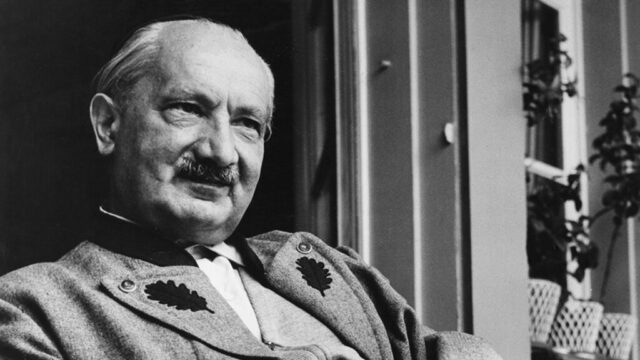The Significance of Heidegger and His History of Philosophy for Russia

As previously noted, it is common in Heidegger studies to divide his philosophical cycle into an early period (phenomenological studies and writing Sein und Zeit), a middle period (little-known, occurring as thought about Ereignis, and including the series of lectures on Nietzsche, the Holzwege, and the lecture cycles of the 1930s, combined into the posthumous collections Beiträge zur Philosopie, Von den Anfang, Geschichte des Seyns, etc.), and a late period (connected with the philosophy of language and the formalization of the description of Geviert).
At all these stages, separate elements of the Heideggerian history of philosophy are scattered in various works. If we aim at their identification, consolidation, and systematic description, we will find them in the earliest works, in Sein und Zeit, and in the hermeneutic period. But they are set out especially explicitly in the middle period. Beiträge zur Philosophie and Geschichte des Seyns, in general, are abstracts of lectures arranged as a history of philosophy, and Einführung in die Metaphysik sheds light on the structure of this history of philosophy and its ontological basis. From this perspective, the famous Heideggerian theory of Dasein will be revealed as the culminating point of the historical and philosophical process, on which this process teleologically converges.
Thus, the works of Heidegger’s middle period give us a framework for clarifying his historical and philosophical schema, onto which theories from other periods of his works are superimposed.
Heidegger’s schema of the history of philosophy
Heidegger’s reconstruction of the history of philosophy can be schematically described as follows. The birth of philosophy in pre-Socratic thought is the great triad of Anaximander, Heraclitus, and Parmenides, which is the first Beginning or the great Beginning. Here philosophy comes from pre-philosophy or nonphilosophy, from thinking. Its forerunner several centuries earlier was Homer’s poetic genius.
According to Heidegger, the first Beginning of philosophy is characterized by the decision of the ontological problem, the question of what is being and how it should be understood. This problem first acquires a clear form in Heraclitus’s teaching on physis and logos. Being as that which makes what is, that which it is, is conceived in the great Beginning as “physis,” that is, the opening, ascending, revealing “power of presence.” For Heidegger, in this teaching of Heraclitus lies the radiant triumph of philosophy and at the same time the first birth of that tendency, which – much later – will lead philosophy to its End. The identification of “being” with “physis” is only a half-correct solution of the ontological problem. Of course, Heidegger thinks, being is physis, the generating force of the world, bringing things and beings to the light of presence, into openness, making the existent [sushcheye] existent, that which is. In this sense, being is an existent [bytiye i yest’ sushcheye], all existence as a whole, that is, physis. But this starting point of philosophy — with all its fundamental majesty — already contains a certain error: by celebrating being as presence and bringing to pres- ence, as existent, the pre-Socratic ontology overlooks the other side of being — the one that leads the existent to nonexistence, to death, the one that nihilates, annihilates the existent. Nothing is hidden behind being, apprehended only as “physis,” disappearing in it. And Parmenides in his famous poem will consolidate this disappearance by the formula “non-being is not.” According to Heidegger, nonbeing, nothing (Nichts) as the to-not (Nichten) is indeed. And pure ontology would have to initially put this “to-not” inside physis, see it in being as its opposite side, different from it and at the same time identical with it. But Greek thought took a different path: it focused on “being” as “physis,” losing sight of “nothing” (because of its nothingness). Thereby, already in the great Beginning, a certain gap arose between how philosophy began to take shape and how it should have taken shape if the ontological problem had been formulated properly. The gap between how it was historically and how it should have been gave rise to two points in the structure of ontology, through which a straight line was drawn that predetermined all the other stages of the history of Western philosophy. As a result, we got a ray with both a trajectory (a line) and an orientation (a direction vector, going from how one should have understood being to how it should not have been understood).
Already in the first Beginning, Heraclitus and Parmenides formalize the fundamental configuration of the entire historical and philosophical process. This process is structured by the main paradigm: a progressive “retreat from being,” “loss of being”, “forgetting about being.”
Logos and nihilism
Compensation for the loss of the distinction of the nihilating side of being in being as “physis” was the appearance of the “logos.” “Logos,” which Heidegger interprets etymologically as “harvest,” “harvesting,” becomes a priority topos, in which the nothing that is lost in the understanding of being as “physis” reminds of itself. This is the specificity of philosophy, the introduction into the game of an nihilating logos, placed this time not in being (as it should have been), but outside of it, at the conditional point that later will become with Aristotle the “upokeimenon” and in modernity the Cartesian “subject.”
Heidegger identifies the work of the logos in the procedure of “techne,” or in what he later calls “Gestell.” If the existence of the world begins to be thought of as a predominantly positive presence, then nothing concentrates more and more on the side of cognition and its dual topos.
Cognition as a process is the root of “techne,” in which there is a rigid splitting of being into physis and logos, into the cognizable and cognizing, which further leads to the arrangement in the center of precisely the the cognizer, the carrier of the logos, deploying its nihilating power onto the sphere of physis, conquering being and in the end, reproducing being as an artificial product. In this limit of the development of the technical beginning, the triumph of nihilism manifests itself. Logos should have been inside physis, but it turned out to be outside, and this became the fate of Western European philosophy, the fate of the West, as well as the meaning and content of its unfolding.
The End of the first Beginning
If the main tendency of Western European philosophy was only outlined in Heraclitus and Parmenides, in Plato and Aristotle its path was clearly fixed. Heidegger calls Platonism and Aristotelianism the “End of the first Begin- ning.” This is still absolutely Greek philosophical thought, breathing ontology and being, but the possibility of interpreting being as something open, the possibility of placing the logos not outside physis, but inside it, is here removed from the agenda. Plato’s doctrine of ideas fixes the prerequisites of the referential theory of truth, formulated fully, which consists in the search for the correspondence of the speculative principle (the idea) and the things of the natural world.
The implementation of this operation concerns reason, the logos.
Being is henceforth thought of as a being, only as the highest being or beings-as-a-whole. Moreover, it is not just a dynamic of natural power, pushing a thing to presence, but a fixed and static visual image, a moment of “luminous intellectual perception” [svetovogo sozertsaniya]. According to Heidegger, this is a fundamental and irreversible step in the diminution of the status of being, now equivalent not simply to physis, but to the idea. Symmetrically to this, the logos, in turn, makes a serious step towards nihilism and the technical relation to the world; the metaphor of the demiurge god, the worker, the artisan who technically manufactures the world starting from fixed images-ideas, begins to dominate.
In his philosophy and history of philosophy, Aristotle fixes the qualitative moment of the End of the pre-Socratic period of Western philosophy. This is an end in all senses, termination (withdrawal) and fulfillment, that is, the achievement of complete maturity, perfection, the fullness of what was incorporated in the thinking of the preSocrates. The philosophy of Aristotle is the hologram of all early Greek philosophy. It summarizes the previous period and lays the foundation for further stages, which is true not only for the Stoics, but also for the later scholastic periods of Western philosophy, and also, to a large extent, for modernity (after all, Kant remarked that the field of logic has not advanced a single step since Aristotle’s philosophy). According to Heidegger, Plato and Aristotle mark the moment of completion of the philosophical Beginning. Next comes the middle period associated with Christianity and scholasticism and, in the broadest sense, called the “Middle Ages.” From the historical and philosophical point of view, these centuries are called “Middle” precisely because they occupy an intermediate position between the philosophy of Antiquity (the philosophy of the first Beginning) and the philosophy of modernity.
https://alexanderdugin.substack.com/p/the-significance-of-heidegger-and-b97
